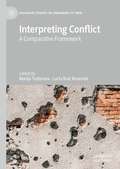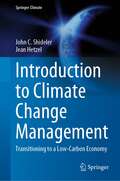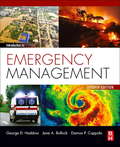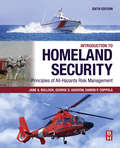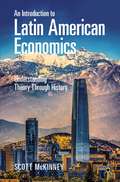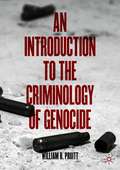- Table View
- List View
Interpreting Conflict: A Comparative Framework (Palgrave Studies in Languages at War)
by Marija Todorova Lucía Ruiz RosendoThis edited book examines the role of interpreting in conflict situations, bringing together studies from different international and intercultural contexts, with contributions from military personnel, humanitarian interpreters and activists as well as academics. The authors use case studies to compare relevant notions of interpreting in conflict-related scenarios such as: the positionality of the interpreter, the ethical, emotional and security implications of their work, the specific training needed to carry out work for military and humanitarian organizations, and the relations of power created between the different stakeholders. The book will be of interest to students and scholars of translation and interpreting, conflict and peace studies, as well as conflict resolution and management.
Interpreting Racial Politics in the United States
by Ronald Schmidt, Sr.Few subjects of social scientific inquiry need interpretive analysis more than the topic of racial politics, yet most US political science employs a narrowly behavioralist orientation. This book argues that it is time for political scientists studying race to more fully engage the issues that generate its political significance. Drawing on the work of interpretive political scholars and methods, Ron Schmidt, Sr. addresses core questions regarding racial politics in the US to demonstrate the value of using interpretive methods to better understand the meaning and significance of political actions, structures and conflicts involving racial identities—not instead of behavioral research but as a necessary addition. Interpreting Racial Politics in the United States will greatly enhance the evolving conversations concerning race and inequality within the US. It will be of great interest to students and scholars of politics and sociology, but also to those interested in deepening their understanding of racial politics.
Interpreting Racial Politics in the United States
by Ronald Schmidt, Sr.Few subjects of social scientific inquiry need interpretive analysis more than the topic of racial politics, yet most US political science employs a narrowly behavioralist orientation. This book argues that it is time for political scientists studying race to more fully engage the issues that generate its political significance. Drawing on the work of interpretive political scholars and methods, Ron Schmidt, Sr. addresses core questions regarding racial politics in the US to demonstrate the value of using interpretive methods to better understand the meaning and significance of political actions, structures and conflicts involving racial identities—not instead of behavioral research but as a necessary addition. Interpreting Racial Politics in the United States will greatly enhance the evolving conversations concerning race and inequality within the US. It will be of great interest to students and scholars of politics and sociology, but also to those interested in deepening their understanding of racial politics.
The Intersection of Environmental Justice, Climate Change, Community, and the Ecology of Life
by Ande A. Nesmith Cathryne L. Schmitz Yolanda Machado-Escudero Shanondora Billiot Rachel A. Forbes Meredith C. Powers Nikita Buckhoy Lucy A. LawrenceThis book examines and encourages the increasing involvement of those in the social sciences, including social work, as well as everyday citizens, with environmental injustices that affect the natural ecology, community health, and physical and mental health of marginalized communities. The authors draw on their diverse experiences in research, practice, and education to suggest interdisciplinary strategies for addressing environmental justice, climate change, and ecological destruction on both a local and global scale. This insightful work presents models for action, practice, and education, including field learning, with examples of how programs and schools have integrated and infused environmental justice content across their curricula. Environmental and ecological impacts on local communities as well as the whole ecology of life are examined. Models for engaging civic dialogue, addressing structural oppression, and employing other interdisciplinary responses to environmental injustices are provided.Topics explored among the chapters include:Water, Air, and Land: The Foundation for Life, Food, and SocietyHuman Health and Well-Being in Times of Global Environmental Crisis Power and Politics: Protection, Rebuilding, and JusticePathways to Change: Community and Environmental TransformationDecolonizing Nature: The Potential of Nature to HealThe Intersection of Environmental Justice, Climate Change, Community, and the Ecology of Life equips readers to identify the impact of the global environmental crisis in their own communities. Emphasizing the need for immediate action on ecological, climate, and environmental justice issues, this forward-thinking book assists social science professionals, educators, researchers, and other concerned individuals with the knowledge needed for creating meaningful interdisciplinary responses in their communities as they take action within a rapidly changing context.
Interviews with North Korean Defectors: From Kim Shin-jo to Thae Yong-ho (Routledge Advances in Korean Studies)
by Lim Il Adam ZulawnikOriginally compiled and written by North Korean defector and author Lim Il, this English-language edition, thoroughly annotated by Dr. Adam Zulawnik, is a fascinating collection of 34 interviews with highly prominent North Korean defectors residing in South Korea, ranging from religious figures, to artists, politicians, North Korea experts, and even divers and subway train operators. The 33 interviews herein are listed chronologically according to the interviewees' date of arrival to South Korea and span almost 70 years. The book also includes six special columns addressing key issues pertaining to North Korean defectors and their lives in South Korea, such as the relationship between North Korean defectors and their South Korean counterparts (South Korean defectors to North Korea; nomenclature (how North Korean defectors have been referred to in South Korean society over time); arrival and settlement provisions from the South Korean government; the nuanced difference between defectors, defector-residents, and the displaced; North Korean defector-residents and their position in South Korean politics; and a short biography of five notable North Korean defector-residents who were not interviewed. The English translation also contains an exclusive 34th interview with Lim Il, the source text author which was carried out towards the end of the project in October 2020. The book is a valuable testament to North Korean defector-residents and unique in that it provides a candid account of each individual’s experience. It will prove to be especially useful to students and scholars seeking to understand the complex dynamics of North Korean society and the status of exiles in South Korea, and a vital resource for students of Korean Studies.
Interviews with North Korean Defectors: From Kim Shin-jo to Thae Yong-ho (Routledge Advances in Korean Studies)
by Lim Il Adam ZulawnikOriginally compiled and written by North Korean defector and author Lim Il, this English-language edition, thoroughly annotated by Dr. Adam Zulawnik, is a fascinating collection of 34 interviews with highly prominent North Korean defectors residing in South Korea, ranging from religious figures, to artists, politicians, North Korea experts, and even divers and subway train operators. The 33 interviews herein are listed chronologically according to the interviewees' date of arrival to South Korea and span almost 70 years. The book also includes six special columns addressing key issues pertaining to North Korean defectors and their lives in South Korea, such as the relationship between North Korean defectors and their South Korean counterparts (South Korean defectors to North Korea; nomenclature (how North Korean defectors have been referred to in South Korean society over time); arrival and settlement provisions from the South Korean government; the nuanced difference between defectors, defector-residents, and the displaced; North Korean defector-residents and their position in South Korean politics; and a short biography of five notable North Korean defector-residents who were not interviewed. The English translation also contains an exclusive 34th interview with Lim Il, the source text author which was carried out towards the end of the project in October 2020. The book is a valuable testament to North Korean defector-residents and unique in that it provides a candid account of each individual’s experience. It will prove to be especially useful to students and scholars seeking to understand the complex dynamics of North Korean society and the status of exiles in South Korea, and a vital resource for students of Korean Studies.
Intimate States: Gender, Sexuality, and Governance in Modern US History
Fourteen essays examine the unexpected relationships between government power and intimate life in the last 150 years of United States history. The last few decades have seen a surge of historical scholarship that analyzes state power and expands our understanding of governmental authority and the ways we experience it. At the same time, studies of the history of intimate life—marriage, sexuality, child-rearing, and family—also have blossomed. Yet these two literatures have not been considered together in a sustained way. This book, edited and introduced by three preeminent American historians, aims to close this gap, offering powerful analyses of the relationship between state power and intimate experience in the United States from the Civil War to the present. The fourteen essays that make up Intimate States argue that “intimate governance”—the binding of private daily experience to the apparatus of the state—should be central to our understanding of modern American history. Our personal experiences have been controlled and arranged by the state in ways we often don’t even see, the authors and editors argue; correspondingly, contemporary government has been profoundly shaped by its approaches and responses to the contours of intimate life, and its power has become so deeply embedded into daily social life that it is largely indistinguishable from society itself. Intimate States makes a persuasive case that the state is always with us, even in our most seemingly private moments.
Intimate States: Gender, Sexuality, and Governance in Modern US History
by Margot Canaday Nancy F. Cott Robert O. SelfFourteen essays examine the unexpected relationships between government power and intimate life in the last 150 years of United States history. The last few decades have seen a surge of historical scholarship that analyzes state power and expands our understanding of governmental authority and the ways we experience it. At the same time, studies of the history of intimate life—marriage, sexuality, child-rearing, and family—also have blossomed. Yet these two literatures have not been considered together in a sustained way. This book, edited and introduced by three preeminent American historians, aims to close this gap, offering powerful analyses of the relationship between state power and intimate experience in the United States from the Civil War to the present. The fourteen essays that make up Intimate States argue that “intimate governance”—the binding of private daily experience to the apparatus of the state—should be central to our understanding of modern American history. Our personal experiences have been controlled and arranged by the state in ways we often don’t even see, the authors and editors argue; correspondingly, contemporary government has been profoundly shaped by its approaches and responses to the contours of intimate life, and its power has become so deeply embedded into daily social life that it is largely indistinguishable from society itself. Intimate States makes a persuasive case that the state is always with us, even in our most seemingly private moments.
The Introduction of e-Government in Switzerland: Many Sparks, No Fire
by Tereza CahlikovaThis book studies the question of e-Government development from a multi-faceted perceptive. The first introductory chapter outlines the importance of public sector digitalisation. The second chapter clarifies the used e-Government terminology and divides the concept between electronic public service delivery and electronic practice of democracy. Influential factors having an impact on the introduction of e-Government projects are divided between those of organisational, institutional, individual and technological nature and discussed in detail in the third chapter. The fourth chapter presents empirical findings from the Swiss case study that constitutes both an exceptional and exemplary model of e-Government development. High quality of public services and the participative style of democracy would seem to predestine the country to be the precursor in the field of e-Government. However, the state of e-Government development does not correspond to the potential that Swiss contextual conditions offer. The importance of the Swiss case study for the understanding of e-Government as an institutional and organisational transformation is outlined in the fifth chapter.
Introduction to Algorithmic Government
by Rajan Gupta Saibal Kumar PalThe world is changing at a fast pace, so is the Government and Governance style. Humans are bound to go for Algorithmic strategies rather than manual or electronic ones in different domains. This book introduces the Algorithmic Government or Government by Algorithm, which refers to authorizing machines in the Public Sector for automated decision-making based on Artificial Intelligence, Data Science, and other technologies. It is an emerging concept introduced globally and will be considered revolutionary in the future. The book covers concepts, applications, progress status, and potential use-cases of Algorithmic Government. This book serves as introductory material for the readers from technology, public policy, administration, and management fields.
Introduction to Climate Change Management: Transitioning to a Low-Carbon Economy (Springer Climate)
by John C. Shideler Jean HetzelThis book provides climate students with the basic scientific background to climate change management. Students will learn about international and national approaches to climate change management defined in voluntary initiatives as well as in national law and international agreements. The book describes mitigation and adaptation measures, monitoring and reporting of greenhouse gas emissions, and strategies for achieving a low-carbon economy, including green finance.This book combines theory and practice, introducing students to the conceptual background but also taking a professional and technical approach with case studies and low carbon toolkits. Filled with didactic elements such as concept schemes, tables, charts, figures, examples, as well as questions and answers at the end of the chapters, this book aims to engage critical thinking and the discussion of important topics of our days.The low-carbon strategy is one of the answers to limiting the greenhouse effect on our planet. This strategy is to minimize the overall carbon consumption in the life cycle of the products we consume, from the extraction of raw materials to the end of their life. The future is being built today. This book will guide its readers along the path of imagining and realizing a low-carbon economy.”
Introduction to Crowd Management: Managing Crowds in the Digital Era: Theory and Practice
by Katsuhiro Nishinari Claudio Feliciani Kenichiro ShimuraThis book will guide you in a simple and illustrative way through all aspects related to crowd behaviour, including sociological theories, methods of crowd control, people detection and tracking, and crowd simulation and prediction, while examining previous accidents to learn from the past. Crowds are a constant presence in most cities around the globe and mass gatherings are attracting an increasing number of people. While experience can help manage large crowds and plan mass events, knowledge on crowd behaviour is fundamental for successfully dealing with unexpected situations, improving current practices and implementing state-of-the-art technologies in management strategies. After letting people laugh about the controversy on colliding pedestrians, with this book, two of the Ig Nobel laureates on pedestrian traffic will make you think (and learn) presenting through a collaborative approach, combining theoretical with practical advice, the science behind crowd dynamics and the importance it plays in our increasingly urbanized society. Fundamental aspects related to crowd management are presented using simple concepts requiring little or no knowledge of mathematics or engineering. Professionals involved in pedestrian traffic, as well as students and researchers entering the field of crowd dynamics, will find this book a useful interdisciplinary introduction on the subject, exploring both fundamental background information and more specific topics related to crowd management.
Introduction to Emergency Management
by Damon P. Coppola Jane A. Bullock George D. HaddowIntroduction to Emergency Management, Seventh Edition, sets the standard for excellence in the field and has educated a generation of emergency managers. This long-trusted resource provides a broad overview of the key aspects of the emergency management profession. Readers will gain an understanding of why the emergency management profession exists, what actions its professionals and practitioners are tasked with performing, and what achievements are sought through the conduct of these various efforts. Students and new professionals alike will further gain an enhanced understanding of key terminology and concepts that enable them to work with emergency management specialists.Emphasizes climate change as a key hazard faced by disaster managersIncludes coverage of social media as a critical tool in emergency managementContains updated ancillaries, new examples, and case studies throughout
An Introduction to Global Health Delivery: Practice, Equity, Human Rights
by Joia MukherjeeIn the last two decades, the rise of global health studies at universities across the world reflects the interest of a growing generation of students motivated to be involved in progressive global change. Grassroots advocacy for health equity and strong leadership in the global South have catalyzed a paradigm shift from primarily preventative health programs to holistic systems providing health care as a human right. To succeed in this field, students must not only understand the elements needed to deliver equitable health care but also the historical and social factors that cause and propagate health disparities. An Introduction to Global Health Delivery, Second Edition is an immersive introduction to global health's origins, actors, interventions, and challenges from the ongoing impacts of racism to the momentum for the delivery of care that began with the AIDS movement through to the current era of COVID-19. Informed by physician Joia Mukherjee's quarter-century of experience fighting disease and poverty in more than a dozen countries, it delivers a clear-eyed overview of the movement underway to address injustice, reduce global health disparities, and deliver health care as a human right. This second edition extends the lens of global health delivery to address the challenges of COVID-19 and the prevention of future pandemics. It features updated chapters exploring pandemics, preparedness, and the intersection of key social movements with the right to health care, including Black Lives Matter, decolonization, and climate justice. Enriched with case studies and exercises that encourage readers to think critically about equitable global health delivery, An Introduction to Global Health Delivery, Second Edition is the essential starting point for readers of any background seeking a practical grounding in global health's promise and progress.
Introduction to Homeland Security: Principles of All-Hazards Risk Management
by Damon P. Coppola Jane A. Bullock George D. HaddowWritten by renowned experts, Introduction to Homeland Security, Sixth Edition, informs users about the concepts and bedrock principles of homeland security. Readers will gain a solid appreciation of the broad range of topics that fall within the expanse of the homeland security umbrella and understand how and why they are so closely interconnected. The text will also provide an overview of the evolutionary process behind modern homeland security structures, which helps users to understand why certain functions exist and how they contribute to national and local security efforts. Unlike most books that focus solely on terrorism, this text covers an expansive range of homeland security topics including all-hazards emergency management, cybersecurity, border and transportation security, immigration and customs enforcement, and others.• Updated material to cover new developments in the field such as increased terror attacks, cybersecurity safeguards, and administrative changes• Balanced account of homeland security in all of its aspects• Authoritative voices from content experts• Critical thinking exercises included for each topic
Introduction to Homeland Security, Third Edition
by David H. McElreath Daniel Adrian Doss Barbara Russo Greg Etter Jeffrey Van Slyke Joseph Skinner Michael Corey Carl J. Jensen III Michael Wigginton, Jr. Robert NationsIntroduction to Homeland Security, Third Edition provides the latest developments in the policy and operations of domestic security efforts of the agencies under the U.S. Department of Homeland Security. This includes the FBI, Secret Service, FEMA, the Coast Guard, TSA and numerous other federal agencies responsible for critical intelligence, emergency response, and the safety and security of U.S. citizens at home and abroad. Changes in DHS and domestic security are presented from pre-September 11, 2001 days, to include the formation of DHS under President George W. Bush, all the way through to the current administration. Through this, the many transformative events are looked at through the lens of DHS’s original establishment, and the frequent changes to the various agencies, organization, reporting structure, funding, and policies that have occurred since. This new edition is completely updated and includes coverage of topics relevant to homeland security operations not covered in any other text currently available. This includes highlighting the geopolitical context and the nature of global terrorism—and their implications—specifically as they relate to threats to the United States. Partnerships and collaboration with global allies are highlighted in the context of their relevance to international trade, domestic policies, training, and security. The book ends with a look at emerging threats and potential new, creative solutions—and initiatives in-process within the government—to respond to and address such threats. Key Features: Explores the history and formation of the Department of Homeland Security, recent developments, as well as the role and core missions of core agencies within DHS Outlines man-made threats, intelligence challenges, and intra-agency communication, planning, and operations Looks critically at the role of geopolitical dynamics, key international allies, and their influence on domestic policy and decision-making Covers the latest developments in programs, legislation, and policy relative to all transportation and border security issues Examines current issues and emerging global threats associated with extremism and terrorism Addresses natural and man-made disasters and the emergency management cycle in preparing for, mitigating against, responding to, and recovering from such events Introduction to Homeland Security, Third Edition remains the premier textbook for criminal justice, homeland security, national security, and intelligence programs in universities and an ideal reference for professionals as well as policy and research institutes.
Introduction to Homeland Security, Third Edition
by David H. McElreath Daniel Adrian Doss Barbara Russo Greg Etter Jeffrey Van Slyke Joseph Skinner Michael Corey Carl J. Jensen III Michael Wigginton, Jr. Robert NationsIntroduction to Homeland Security, Third Edition provides the latest developments in the policy and operations of domestic security efforts of the agencies under the U.S. Department of Homeland Security. This includes the FBI, Secret Service, FEMA, the Coast Guard, TSA and numerous other federal agencies responsible for critical intelligence, emergency response, and the safety and security of U.S. citizens at home and abroad. Changes in DHS and domestic security are presented from pre-September 11, 2001 days, to include the formation of DHS under President George W. Bush, all the way through to the current administration. Through this, the many transformative events are looked at through the lens of DHS’s original establishment, and the frequent changes to the various agencies, organization, reporting structure, funding, and policies that have occurred since. This new edition is completely updated and includes coverage of topics relevant to homeland security operations not covered in any other text currently available. This includes highlighting the geopolitical context and the nature of global terrorism—and their implications—specifically as they relate to threats to the United States. Partnerships and collaboration with global allies are highlighted in the context of their relevance to international trade, domestic policies, training, and security. The book ends with a look at emerging threats and potential new, creative solutions—and initiatives in-process within the government—to respond to and address such threats. Key Features: Explores the history and formation of the Department of Homeland Security, recent developments, as well as the role and core missions of core agencies within DHS Outlines man-made threats, intelligence challenges, and intra-agency communication, planning, and operations Looks critically at the role of geopolitical dynamics, key international allies, and their influence on domestic policy and decision-making Covers the latest developments in programs, legislation, and policy relative to all transportation and border security issues Examines current issues and emerging global threats associated with extremism and terrorism Addresses natural and man-made disasters and the emergency management cycle in preparing for, mitigating against, responding to, and recovering from such events Introduction to Homeland Security, Third Edition remains the premier textbook for criminal justice, homeland security, national security, and intelligence programs in universities and an ideal reference for professionals as well as policy and research institutes.
Introduction to International Migration: Population Movements in the 21st Century
by Jeannette Money Sarah P. LockhartIntroduction to International Migration introduces students to state-of-the-art knowledge on international migration, a contemporary issue of central importance to virtually all countries around the globe. Original chapters by prominent women migration scholars cover a complex and multifaceted issue area including various types of migration, the mechanisms of migration governance, the impact of migration on both host and home societies, the migrants themselves in a transnational space, and the nexus between migration and other aspects of globalization. Key topics include labor, gender, citizenship, public opinion, development, security, climate, and ethics. Refugee flows are tracked from beginning to end. Photos, figures, text boxes with real-world examples, discussion questions, and recommended readings provide pedagogical structure for each chapter. Intended as a core text for courses on migration and immigration and a supplement to more general courses in global studies, this book is appropriate for both undergraduate and graduate students in the variety of disciplines that deal with the challenges of international migration. Special Features Consistently structured original chapters by notable scholars include an Introduction, Empirical Overview, Theoretical Evolution, Continuing Issues, and Summary for every chapter. Chapter pedagogy includes Discussion Questions, Suggested Readings, and References as well as a Data Appendix for the book. Photos with thematic captions and Text Boxes on hot topics round out the visual and substantive appeal of the text.
Introduction to International Migration: Population Movements in the 21st Century
by Jeannette Money; Sarah P. LockhartIntroduction to International Migration introduces students to state-of-the-art knowledge on international migration, a contemporary issue of central importance to virtually all countries around the globe. Original chapters by prominent women migration scholars cover a complex and multifaceted issue area including various types of migration, the mechanisms of migration governance, the impact of migration on both host and home societies, the migrants themselves in a transnational space, and the nexus between migration and other aspects of globalization. Key topics include labor, gender, citizenship, public opinion, development, security, climate, and ethics. Refugee flows are tracked from beginning to end. Photos, figures, text boxes with real-world examples, discussion questions, and recommended readings provide pedagogical structure for each chapter. Intended as a core text for courses on migration and immigration and a supplement to more general courses in global studies, this book is appropriate for both undergraduate and graduate students in the variety of disciplines that deal with the challenges of international migration. Special Features Consistently structured original chapters by notable scholars include an Introduction, Empirical Overview, Theoretical Evolution, Continuing Issues, and Summary for every chapter. Chapter pedagogy includes Discussion Questions, Suggested Readings, and References as well as a Data Appendix for the book. Photos with thematic captions and Text Boxes on hot topics round out the visual and substantive appeal of the text.
An Introduction to Latin American Economics: Understanding Theory Through History
by Scott McKinneyThis textbook serves as an introduction to the major economic topics and events in Latin America’s history, from the settling of the region by indigenous Americans and then Europeans, Africans and Asians, to the economic consequences of COVID-19. Each chapter concentrates on a particular period—for example, pre-Columbian America, the 1980s debt crisis, the 21st Century decline in income inequality—and introduces the concepts needed to understand the events of that period. These concepts include theories such as Dutch Disease and Dependency Theory, policies such as import-substituting industrialization and neoliberalism, and analytical tools such as the circular flow of income and the foreign exchange market. Descriptive data are used to illustrate these concepts: for example, Latin America’s current account balance during the 1970s and 1980s shows the impact of the debt crisis, while the relationship between money supply growth and inflation in Argentina during the 1980s and 1990s shows the impact of expansionary monetary policy and convertibility.With its focus on Latin American economic history and on the key concepts for understanding that history, this book can serve as the core textbook for an introductory course on Latin American Economics, or as a complementary text for an introductory course in Latin American Studies or a social science course on Latin America.
Introduction to Space Syntax in Urban Studies
by Akkelies van Nes Claudia YamuThis open access textbook is a comprehensive introduction to space syntax method and theory for graduate students and researchers. It provides a step-by-step approach for its application in urban planning and design. This textbook aims to increase the accessibility of the space syntax method for the first time to all graduate students and researchers who are dealing with the built environment, such as those in the field of architecture, urban design and planning, urban sociology, urban geography, archaeology, road engineering, and environmental psychology. Taking a didactical approach, the authors have structured each chapter to explain key concepts and show practical examples followed by underlying theory and provided exercises to facilitate learning in each chapter. The textbook gradually eases the reader into the fundamental concepts and leads them towards complex theories and applications. In summary, the general competencies gain after reading this book are:– to understand, explain, and discuss space syntax as a method and theory;– be capable of undertaking various space syntax analyses such as axial analysis, segment analysis, point depth analysis, or visibility analysis;– be able to apply space syntax for urban research and design practice;– be able to interpret and evaluate space syntax analysis results and embed these in a wider context;– be capable of producing new original work using space syntax.This holistic textbook functions as compulsory literature for spatial analysis courses where space syntax is part of the methods taught. Likewise, this space syntax book is useful for graduate students and researchers who want to do self-study. Furthermore, the book provides readers with the fundamental knowledge to understand and critically reflect on existing literature using space syntax.
An Introduction to the Criminology of Genocide
by William R. PruittThis textbook provides an accessible and interdisciplinary introduction to genocide with an emphasis on the criminal aspect of genocide. It draws on sociological, political, and historical concepts to discuss how they contribute to our understanding of genocide as an international crime. It walks students through the evolution of genocide as a criminal act and the legal responses available using case studies to demonstrate how concepts work in action. It combines Criminology and Law, arguing that Criminology can help explain the ‘why and how’ while Law can explain the responses to crime. This textbook includes a chapter on genocide denial as well as discussion questions at the end of the chapters, boxed examples, and further reading. It speaks to students in Criminology, Law, Socio-Legal Studies, and beyond, as well as to practitioners in the criminal justice field.
Introduction to Unmanned Aircraft Systems
by Douglas M. Marshall Eric Shappee R. Kurt BarnhartIntroduction to Unmanned Aircraft Systems, Third Edition surveys the basics of unmanned aircraft systems (UAS), from sensors, controls, and automation to regulations, safety procedures, and human factors. Featuring chapters by leading experts, this fully updated bestseller fills the need for an accessible and effective university textbook. Focussing on the civilian applications of UAS, the text begins with an historical overview of unmanned aerial vehicles, and proceeds to examine each major UAS subsystem. Its combination of understandable technical coverage and up-to-date information on policy and regulation makes the text appropriate for both Aerospace Engineering and Aviation programs.
Introduction to Unmanned Aircraft Systems
by R. Kurt BarnhartIntroduction to Unmanned Aircraft Systems, Third Edition surveys the basics of unmanned aircraft systems (UAS), from sensors, controls, and automation to regulations, safety procedures, and human factors. Featuring chapters by leading experts, this fully updated bestseller fills the need for an accessible and effective university textbook. Focussing on the civilian applications of UAS, the text begins with an historical overview of unmanned aerial vehicles, and proceeds to examine each major UAS subsystem. Its combination of understandable technical coverage and up-to-date information on policy and regulation makes the text appropriate for both Aerospace Engineering and Aviation programs.
The Invention of International Order: Remaking Europe after Napoleon
by Professor Glenda SlugaThe story of the women, financiers, and other unsung figures who helped to shape the post-Napoleonic global orderIn 1814, after decades of continental conflict, an alliance of European empires captured Paris and exiled Napoleon Bonaparte, defeating French military expansionism and establishing the Concert of Europe. This new coalition planted the seeds for today's international order, wedding the idea of a durable peace to multilateralism, diplomacy, philanthropy, and rights, and making Europe its center. Glenda Sluga reveals how at the end of the Napoleonic wars, new conceptions of the politics between states were the work not only of European statesmen but also of politically ambitious aristocratic and bourgeois men and women who seized the moment at an extraordinary crossroads in history.In this panoramic book, Sluga reinvents the study of international politics, its limitations, and its potential. She offers multifaceted portraits of the leading statesmen of the age, such as Tsar Alexander, Count Metternich, and Viscount Castlereagh, showing how they operated in the context of social networks often presided over by influential women, even as they entrenched politics as a masculine endeavor. In this history, figures such as Madame de Staël and Countess Dorothea Lieven insist on shaping the political transformations underway, while bankers influence economic developments and their families agitate for Jewish rights.Monumental in scope, this groundbreaking book chronicles the European women and men who embraced the promise of a new kind of politics in the aftermath of the Napoleonic wars, and whose often paradoxical contributions to modern diplomacy and international politics still resonate today.
